Pelagos-Marine Mammal Sanctuary
Pelagos-Marine Mammal Sanctuary
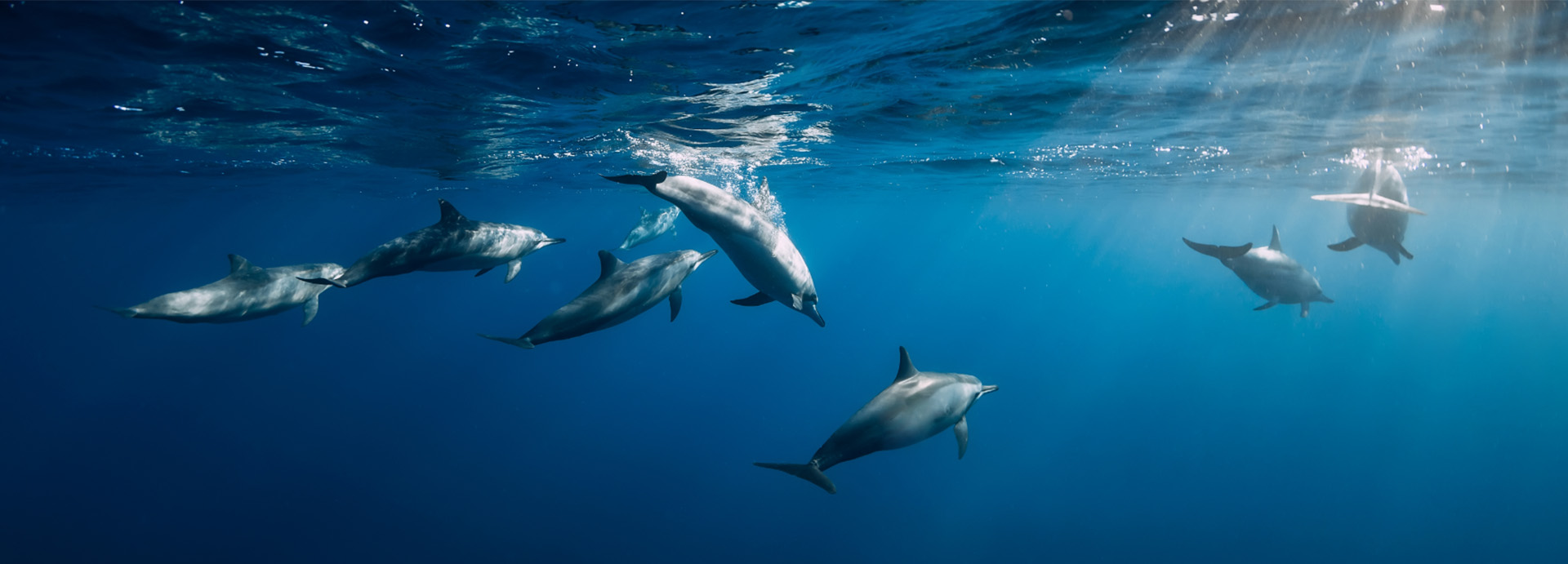
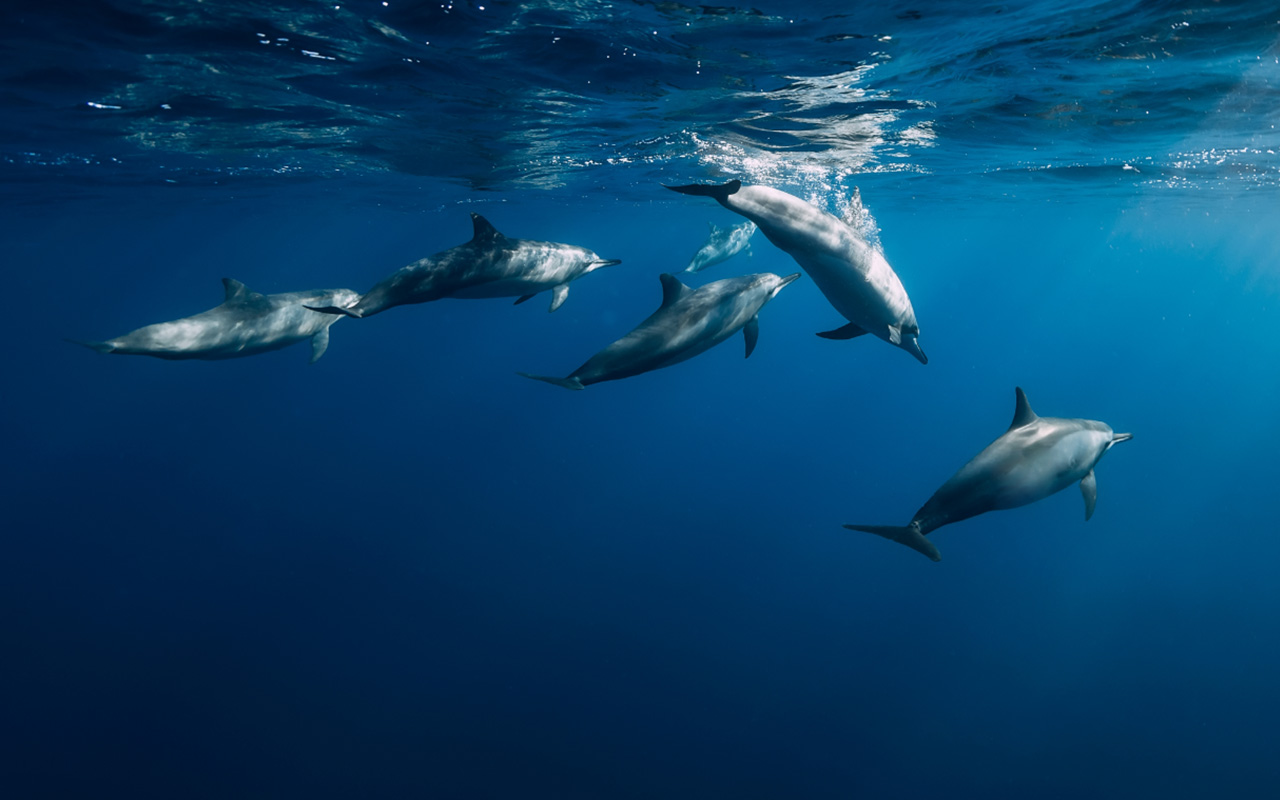
Overview
A marine area of 87,500 sq km subject to an agreement between Italy, Monaco and France for the protection of the marine mammals that live in it.
A rough estimate lists more than 8,500 macroscopic animal species representing between 4 % and 18 % of global marine species, a remarkable biodiversity, particularly with regard to the number of predators at the top of the food chain such as marine mammals, since Mediterranean represents only 0.82 % of the area and 0.32 % of the volume of the world’s oceans.
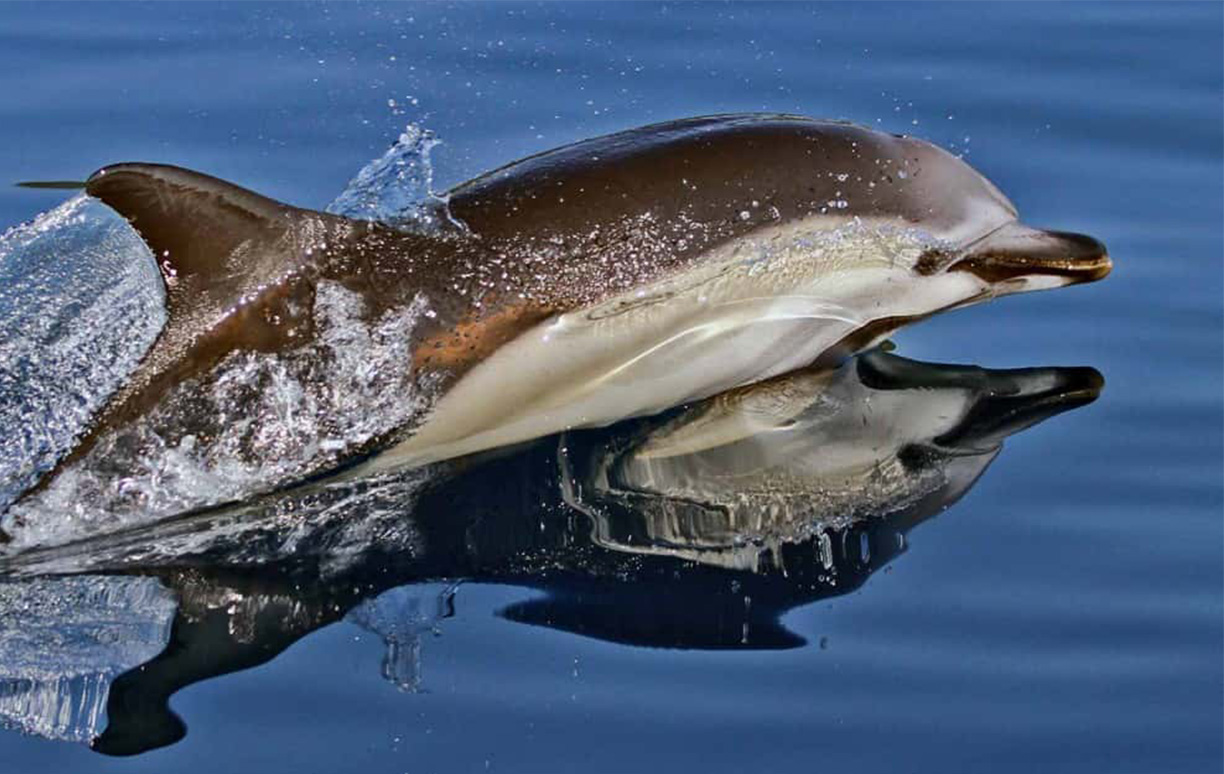
Short Beaked Common Dolphin
What do short-beaked common dolphins look like?
Short-beaked common dolphins have distinctive colouring with multiple colour bands along their sides. Predominantly black or dark grey in colour, forward of the dorsal fin their flanks have a flash of yellow whilst behind the dorsal fin it is white. This colouration forms a beautiful hourglass pattern on their sides. Although the taxonomic debate rages on, there are some differences between the short-beaked and long-beaked common dolphins with the short-beaked slightly stockier than the long-beaked, possessing a more rounded melon and as its name suggests, a shorter beak.
What’s life like for a short-beaked common dolphin?
Fast and furious for this friendly, sociable dolphin. Short-beaked common dolphins typically travel in large groups numbering between 10 and 50 dolphins, and occasionally, hundreds if not thousands. They are incredibly acrobatic and can often be seen breaching and breaking the water’s surface at high speed, a behaviour which can be seen from some distance away. Entire pods will take turns to bow-ride all shapes and sizes of boat and they are often seen with other marine mammals (sometimes even bow-riding the wake of large whales) and feeding seabirds. Life however, can also be fraught with danger as short-beaked common dolphins are hunted throughout their range and are also increasingly becoming accidentally entangled in fishing gear.
What do short-beaked common dolphins eat?
A varied diet. They tend to focus mostly on fish found in mid-water depths, like mackerel, herring and other schooling fish but also enjoy a tasty squid every now and then. Short-beaked common dolphins are also known to be cooperative feeders, working with pod mates to drive prey into an easily accessible ‘bait-ball.
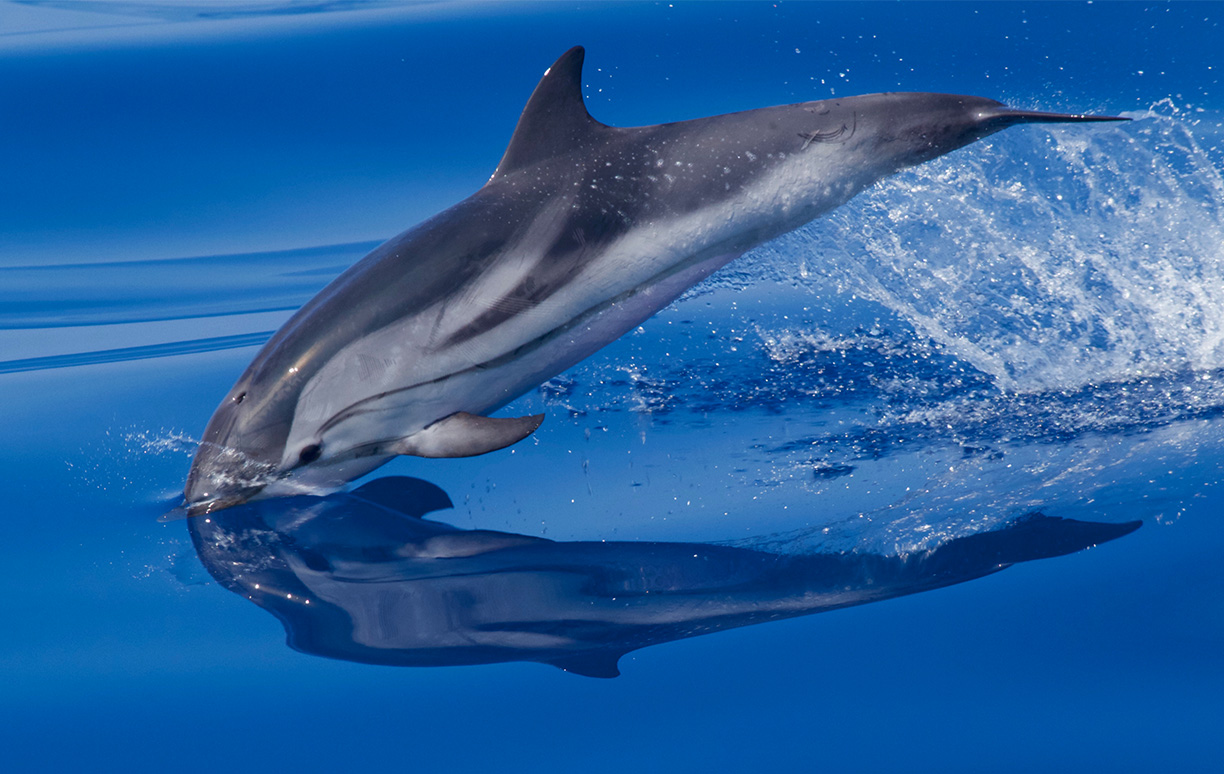
Striped Dolphin
An extremely active and fast and spend a lot of time at the surface. At top speed, up to one third of a pod can be above the surface at any one time and they can leap a distance of three times their length – putting any human long-jumper to shame!
What do striped dolphins look like?
Striped dolphins are relatively small, streamlined and colourful. As the name suggests, the most recognisable features are the ‘stripes’. A dark grey stripe runs from the beak, above the eye, across the flank and then down to the underside of the body. A second stripe runs below the eye to the pectoral flipper.
What’s life like for a striped dolphin?
Fast and furious. Striped dolphins are extremely sociable and travel in large groups – sometimes at top speeds. They are extremely active at the surface and perform some amazing acrobatics including somersaults, breaching, leaping and upside down porpoising. Life can also be dangerous as these little dolphins are targeted for their meat in several countries around the world, most notably in Japan.
What do striped dolphins eat?
Fish is a firm favourite for these little dolphins and they dine out on the smaller varieties, like lantern-fish, found in mid or deep water. They also enjoy munching on a squid or two.
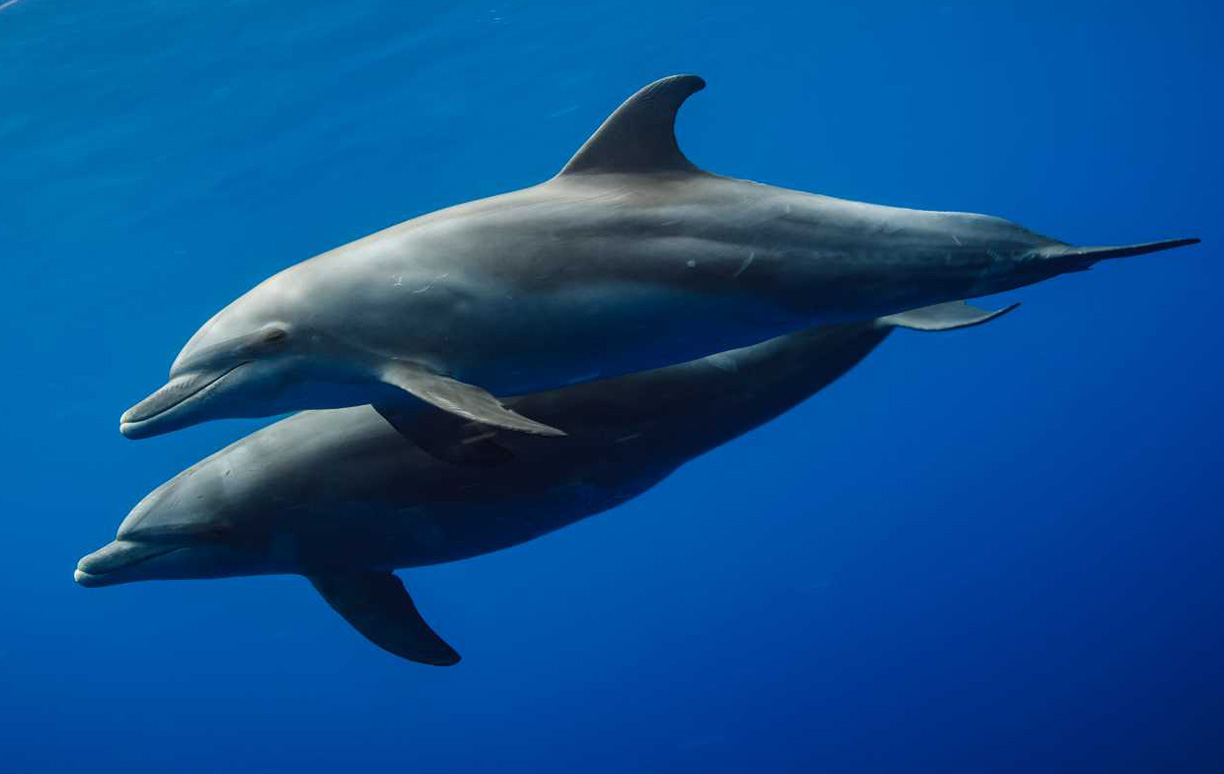
Common Bottlenosed Dolphin
What do bottlenose dolphins look like?
If you imagine a dolphin, it’s likely you are picturing a common bottlenose dolphin. Because of films and TV shows like Flipper and decades of exploitation for human amusement, bottlenose dolphins are the most recognisable of all dolphin species. They are generally relatively large, chunky individuals with a dark grey back and paler belly. They have a short, stubby beak and that endearing mouth shape that makes them look as though they are smiling – an unfortunate feature if you think about how attractive that ‘smile’ has made them to the ‘entertainment’ industry. Individuals can be recognised by distinct notches and markings on their dorsal fin, as unique as our fingerprints.
What’s life like for a bottlenose dolphin?
If you are a bottlenose dolphin, your family and friends are vital. You rely on them for companionship and fun, and they also help you to find and catch food. They babysit your kids when you need to scope out new hunting grounds, and they will rally round when you are sick. Although some individuals choose to live alone, by far the majority are highly social and will also associate with other species of dolphins, whales and even sharks and turtles. Some even cooperate with humans to catch fish.
What do bottlenose dolphins eat?
What a bottlenose dolphin eats will depends on where they live. For the most northerly resident population of common bottlenose dolphins in Scotland’s Moray Firth, there’s nothing better than a plump tasty salmon. For others it’s squid and crustaceans. They swallow their food whole and if you watch a dolphin hunting fish, you will often see them tossing it into the air to get a better angle so that it slides down their throat more easily. Mothers will spend years teaching their calves the best places to go to find food, and passing on tips and tricks for successful hunting.
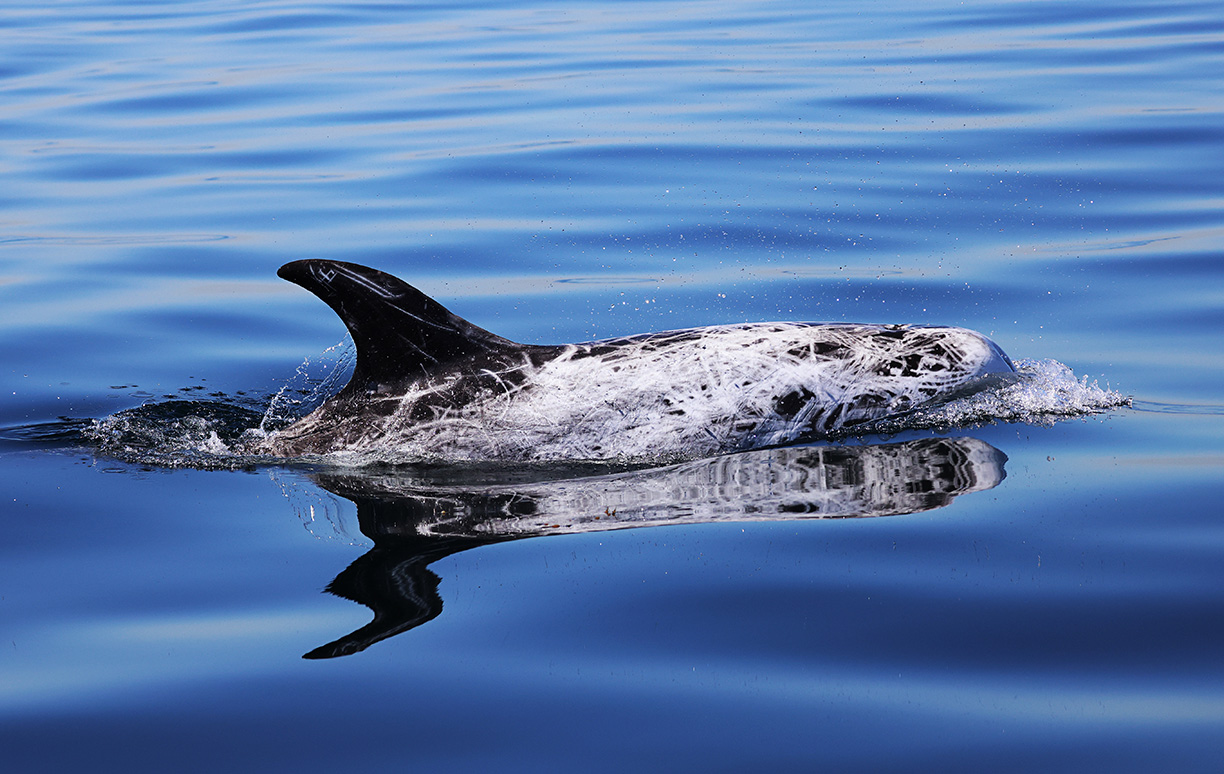
Risso’s Dolphin
What do Risso’s dolphins look like?
Unlike any other dolphin. They are very stocky dolphins with blunt heads and no discernible beak. Although they start out in life a grey/olive brown colour, as they get older they get whiter and whiter – a result of numerous scars and scratches from other Risso’s dolphins and their favourite food, squid!
What’s life like for a Risso’s dolphin?
Busy and incredibly sociable. Risso’s normally like the company of several other pod mates, sometimes lots, and although they’re normally boat-shy, they can be seen leaping out the water, breaching, tail and head-slapping and generally having a very active time. They’re also seen interacting with other species including bottlenose dolphins.
What do Risso’s dolphins eat?
Squid, squid and more squid! As with other species of whale and dolphin, what you eat can be determined by whereabouts in the world you live. So although squid is a favourite, Risso’s are also known to eat prawns and shrimp as well as cuttlefish.
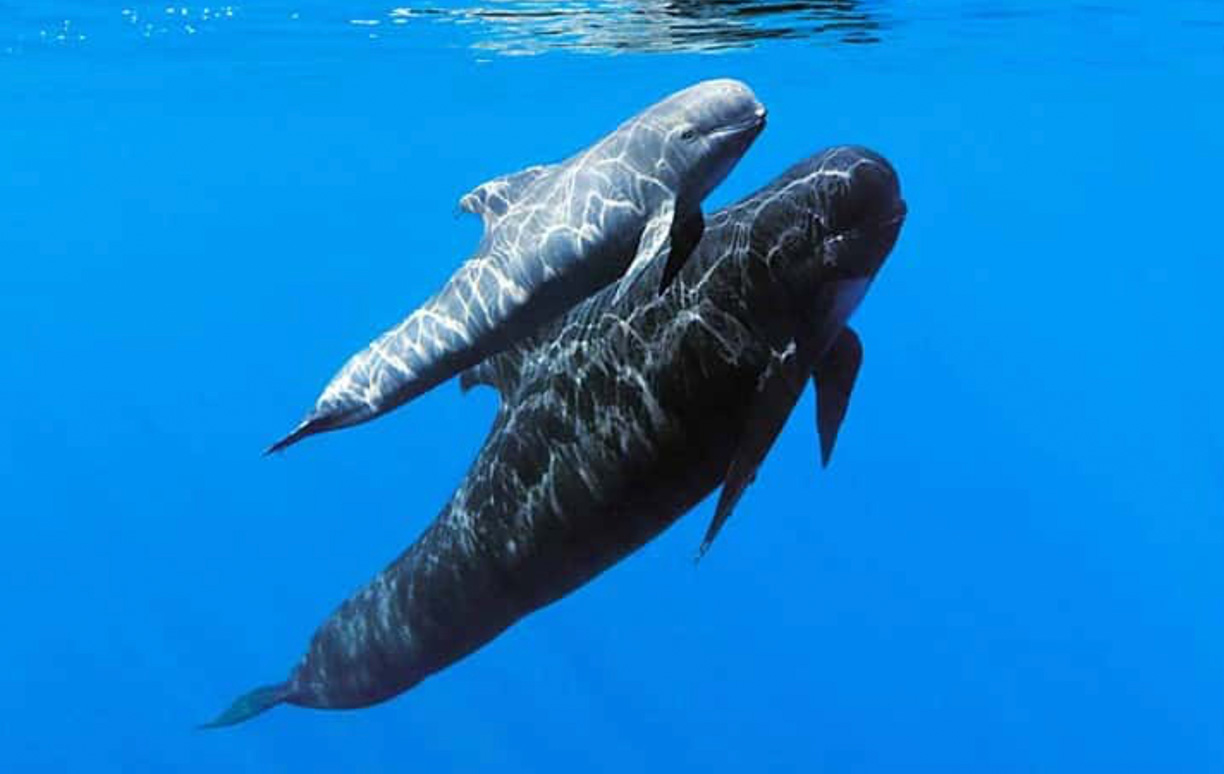
Long-finned Pilot Whale
What do long-finned pilot whales look like?
As their name suggests, they have two very long flippers; they are crescent-shaped and have pointy tips. Adult pilot whales are black or dark grey and have a lighter grey saddle patch on the back behind the dorsal fin and an anchor-shaped patch on the underside. Pilot whale babies are paler coloured. Pilot whales are long, robust whales and have a thick-set, curved (sometimes hooked), and very prominent dorsal fin. The head is bulbous with no beak. Male pilot whales are larger than females, and they have a more bulbous forehead and chunkier dorsal fin.
What’s life like for a long-finned pilot whale?
Pilot whales have a very sociable and inquisitive nature. They are long-lived and live together in multi-generational, tight-knit, stable pods. There are usually more females than males as their pods are built on units of mothers and their offspring. Baby pilots grow up within the safety of the pod they are born into and remain within the same pod for life. Older females or those who are not giving birth themselves, help mothers in the pod care for their babies. Pilot whales are strongly bonded to each other and do everything together; resting, hunting, socialising, playing and travelling as a unified pod. The most important thing in their lives is each other and they are incredibly loyal. There can be anything from 10 to 20 all the way up to a hundred pilot whales living together in a pod. Huge multi-pod get-togethers of hundreds or even a thousand pilot whales give ample opportunity for males to mix and breed with females from other families.
Pilot whales are often active at the surface; they may spyhop (poke their heads out of the water), or lobtail (lift their flukes out of the water and splash them down). They are also regularly seen resting (logging) in unison, close to each other at the surface.
Sometimes they will approach vessels moving at slow speeds and will often allow slow-moving whale-watch boats to approach them.
Pilot whales can dive to depths of over 600m for 10 to 16 minutes at a time to hunt. They mostly feed at night in deep water using echolocation to find prey.
The total worldwide population size may number several hundred thousand whales.
What do long-finned pilot whales eat?
Mainly squids and octopus; these cephalopods are definitely their favoured food. They do sometimes eat fish such as mackerel, hake, herring and cod. Their squid eating lifestyle is evident when looking inside their mouths as they have far fewer teeth than dolphins that prefer fish. Pilot whales ‘ram and suck’ squid into their mouths and so their mouths are adapted for sucking rather than grasping prey.
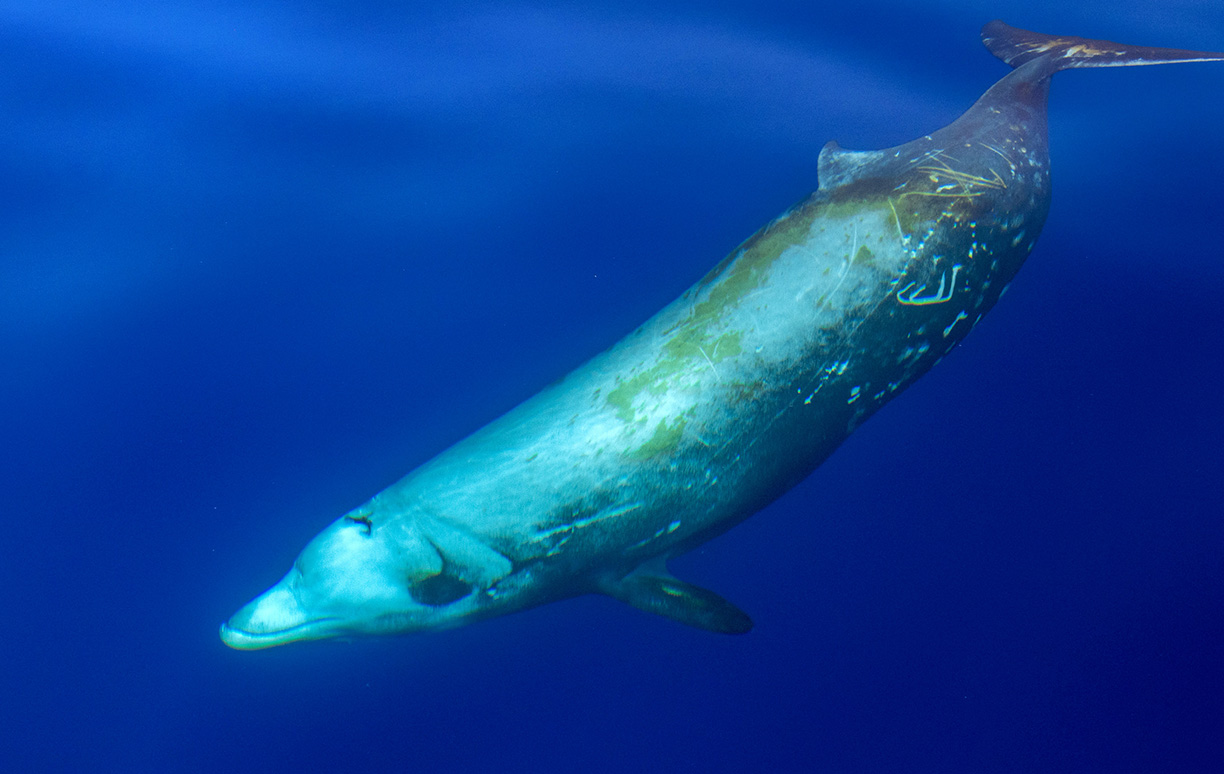
Cuvier’s Beaked Whale
What do Cuvier’s beaked whales look like?
The Cuvier’s beaked whale is one of the larger members of the beaked whale family. The body is torpedo-shaped and robust; the back and sides are dark grey and the belly and head are much lighter. In older males the head and much of the back is white. In some locations, their bodies appear brownish because they are covered in algae. They have panda-like dark rings around each eye.
They also have ‘scars’ from their rather active lifestyle. They have white circular scars all over their bodies; bites from cookie-cutter sharks! Males also have lots of scars made by the teeth of other males during fights.
Cuvier’s have a cone-shaped head, with a stubby beak and two throat grooves. The short mouth-line curves upwards and looks like a smile. They have a small dorsal fin positioned two-thirds of the way back on the body. The flippers are relatively small and the tail flukes are large. Males have only two teeth at the tip of the lower jaw and they often protrude like small tusks in older males. Females don’t have any visible teeth.
What’s life like for a Cuvier’s beaked whale?
Cuvier’s beaked whales are seen in groups of two to seven individuals and often alone. Although their groups tend to be small like all toothed whales they are very social. Cuvier’s live far out to sea where they make long, deep dives searching for squid during both day and night. Since they don’t have teeth to grip their prey, Cuvier’s use a suction method to feed; they slurp and suck squid into their mouths!
Cuvier’s are hard to find because they live in deep water and spend only short periods at the surface to breathe. They do breach occasionally in some parts of the world such as Hawaii, but often they rest motionless near the surface and their small blows are not easy to spot. Cuvier’s sometimes raise their tail flukes above the water which helps them dive steeply down.
Males fight over females; they use their teeth as weapons and they have numerous tooth-rake scrapes and scars on their head and back to prove it.
What do they eat?
They love squid and eat at least 47 different species. They also occasionally eat fish and crustaceans.
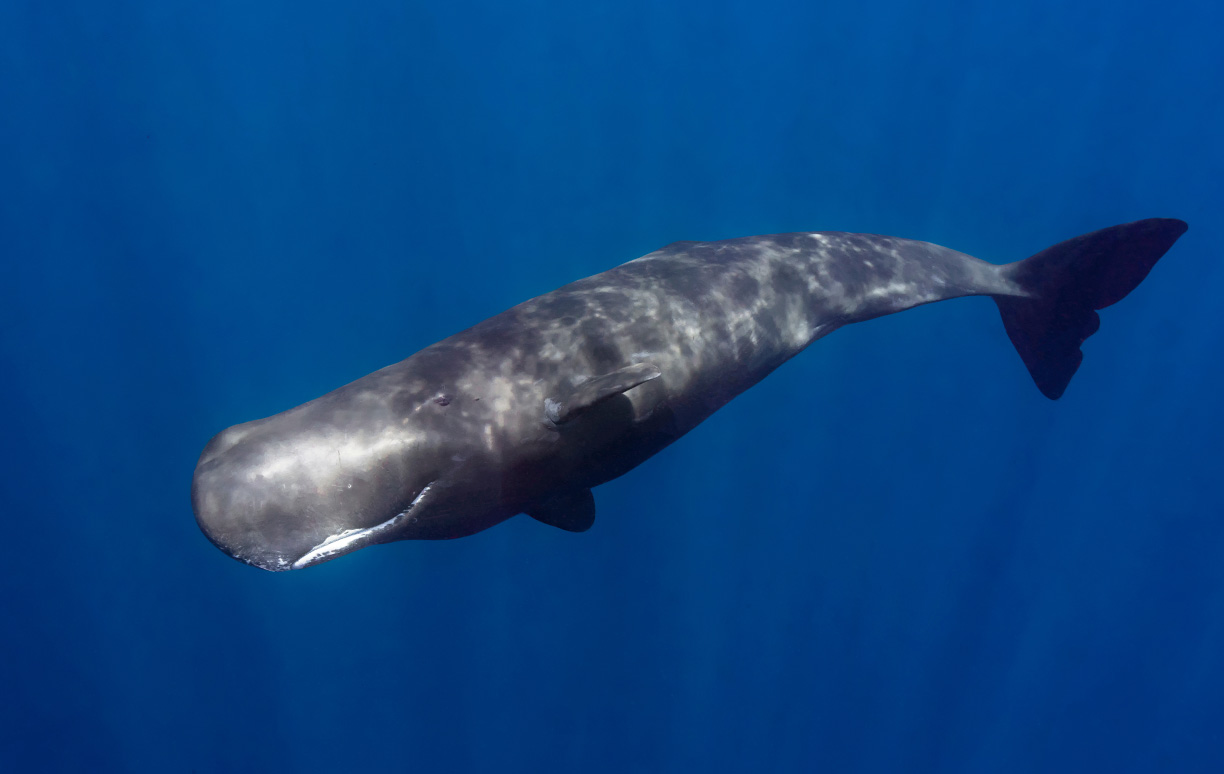
Sperm Whale
What do sperm whales look like?
The mighty sperm whales look nothing like any other whale. For a start, they each have an enormous square-shaped head which accounts for around a third of their body length. They have stumpy dorsal fins and two relatively small pectoral fins on either side of their wrinkle-covered bodies. Even a sperm whale’s blow hole is different: just a single exhalation which rises to the left. Perhaps their most recognizable trait though is their jaw, containing up to 52 cone-shaped teeth in the lower half, weighing a kilo each!
What’s life like for a sperm whale?
Take a deep breath. Spending much of their lives hunting in the deep for their prey, sperm whales can dive to depths of up to 3km and hold their breath for an incredible 2 hours.
Immense diving prowess aside, the social structures of sperm whales are not totally unlike that of humans. Young male sperm whales often hang out in groups, until they are around 30 years when they tend to go their separate ways. Females on the other hand like to spend more time together and join in ‘nursery schools’ to look after young, protecting their babies from predatory sharks or orcas who might be feeling brave enough to take them on.
What do sperm whales eat?
Sourcing their food from the ocean depths, sperm whales use a highly advanced echolocation system that enables them to navigate in this murky, cold world. A firm favourite amongst sperm whales, giant squid top the menu. Unlike many creatures featured in literature and folklore, giant squid really do exist, but even at over 10 meters in length, they are no match for a sperm whale. That said, they put up a good fight, and many whales carry the scars of their underwater encounters. More manageable smaller squid, octopus, fish and crustaceans are also appetising treats, as well as some deep-dwelling sharks.
Diving into the darkness
A sperm whale will dive 2-3km in search of prey and hold its breath for up to two hours, although 45 minutes is the average dive time. Light only penetrates a limited distance underwater so it uses echolocation to find its way around and hunt for squid.
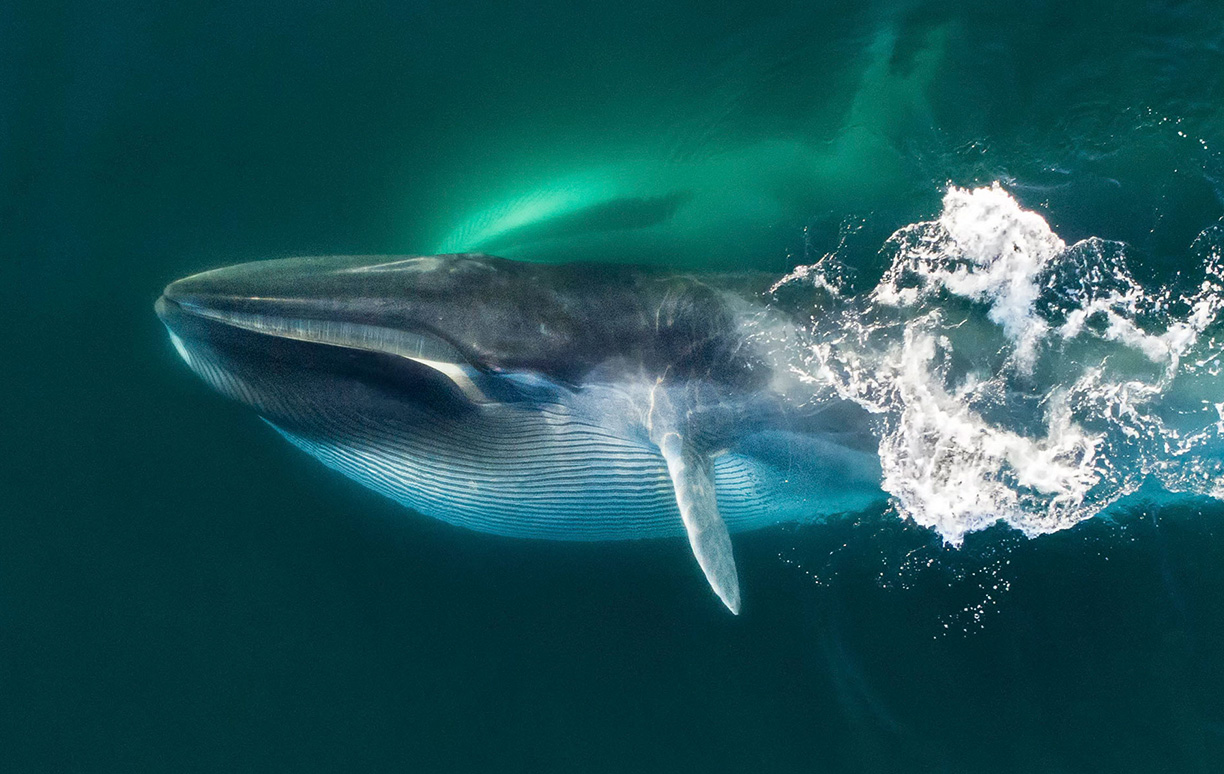
Fin Whale
What do fin whales look like?
Truly handsome individuals, fin whales have long, slender bodies that can grow up to a whopping 80 feet in length. With a distinct ridge running behind the dorsal fin, they have earned themselves the nickname “razorbacks” and cut through the water with ease. Like other baleen whales, fin whales have expandable pleats that allow them to take in huge amounts of water and food. They then sieve the water out through their baleen plates before ingesting their delicious meal, consuming up to 2,000kg of krill in a day.
A little asymmetrical
Mostly sporting grey, dark brown and black tones with a gorgeous pale belly, from a distance there might not seem anything unusual about fin whales. However, on closer inspection they have one very striking feature. Whilst on their left side their lower jaw is black, on the right side it is a brilliant white. The difference in colouration between each side of the body is called “asymmetrical pigmentation” and is only found in one other whale species, Omura’s whale. Some scientists believe this unusual characteristic may have something to do with hunting strategies, although nothing is certain.
What’s life like for a fin whale?
Generally found alone or in pairs, fin whales are mostly solitary and are rarely found in groups. Babies stay with their mums for around one year and learn all about the dos and don’ts in this time. Unlike other whales, fin whales are not too fond of the spotlight. They only rarely breach or spyhop, even avoiding raising their fluke out of the water for much of the time. Despite their seeming shyness, fin whales have no qualms when it comes to mixing with some other species of whales and have even been known to breed with blue whales, giving birth to hybrid calves!
On the whole, life for fin whales has been particularly hard. Relentlessly hunted for their oil, meat and baleen, their numbers have been radically reduced by whalers, though in the earlier days of whaling they were often too fast to be caught by the whale boats. These days, the struggle is ongoing, and the dangers of whaling industries are a constant threat. Despite recognising their vulnerable status, some whalers continue to target fin whales.
What do fin whales eat?
Fin whales have a pretty simple diet, consisting of krill, small fish and crustaceans. However, when you are that big and your prey is that small, you have to eat a lot to survive. In order to get their fill, fin whales can spend several hours each day feeding, gulping up to 70 cubic metres of water in one go before sieving it out. With such big tummies to fill, fin whales can consume up to 2000kg of krill every day.


